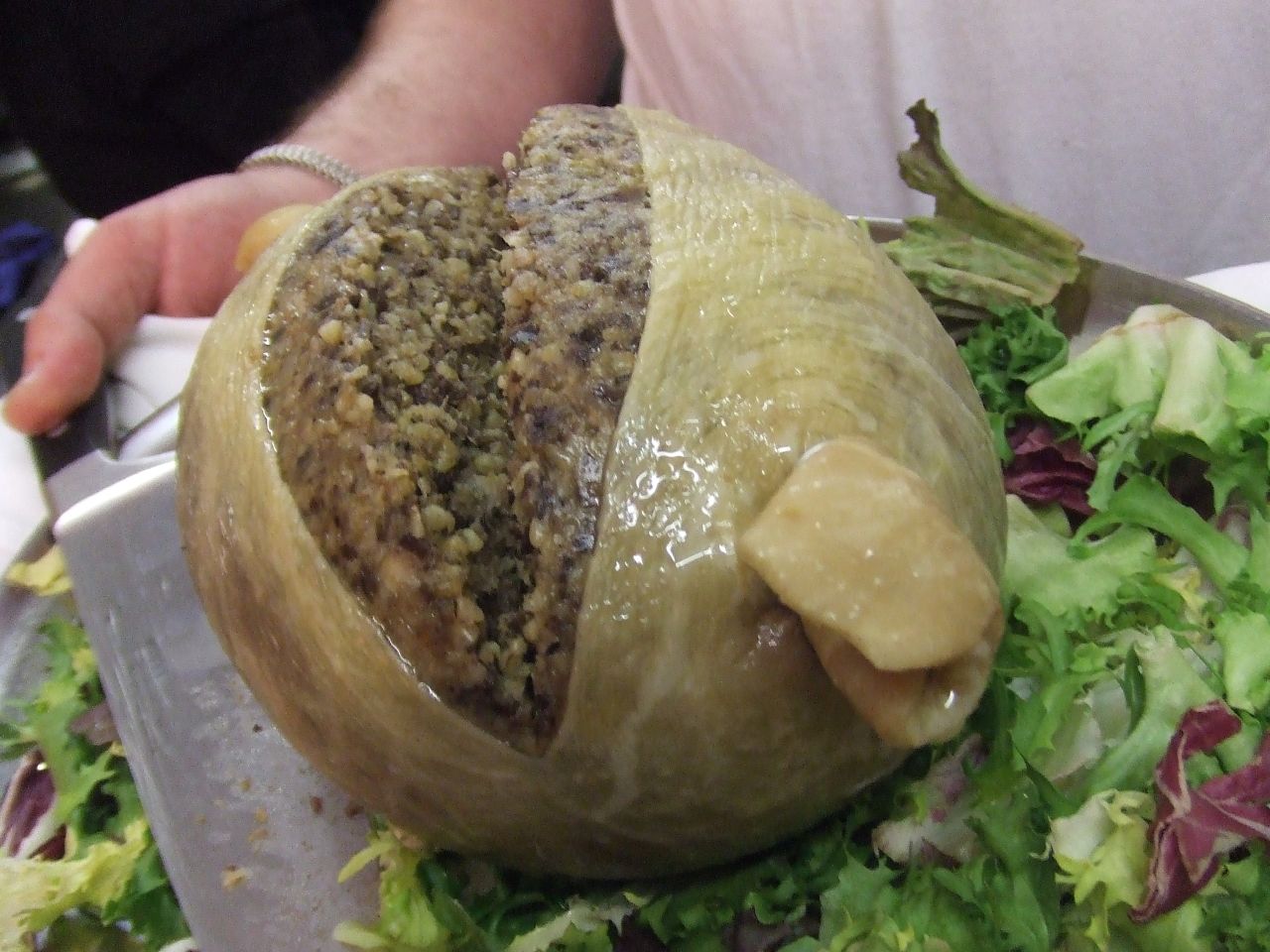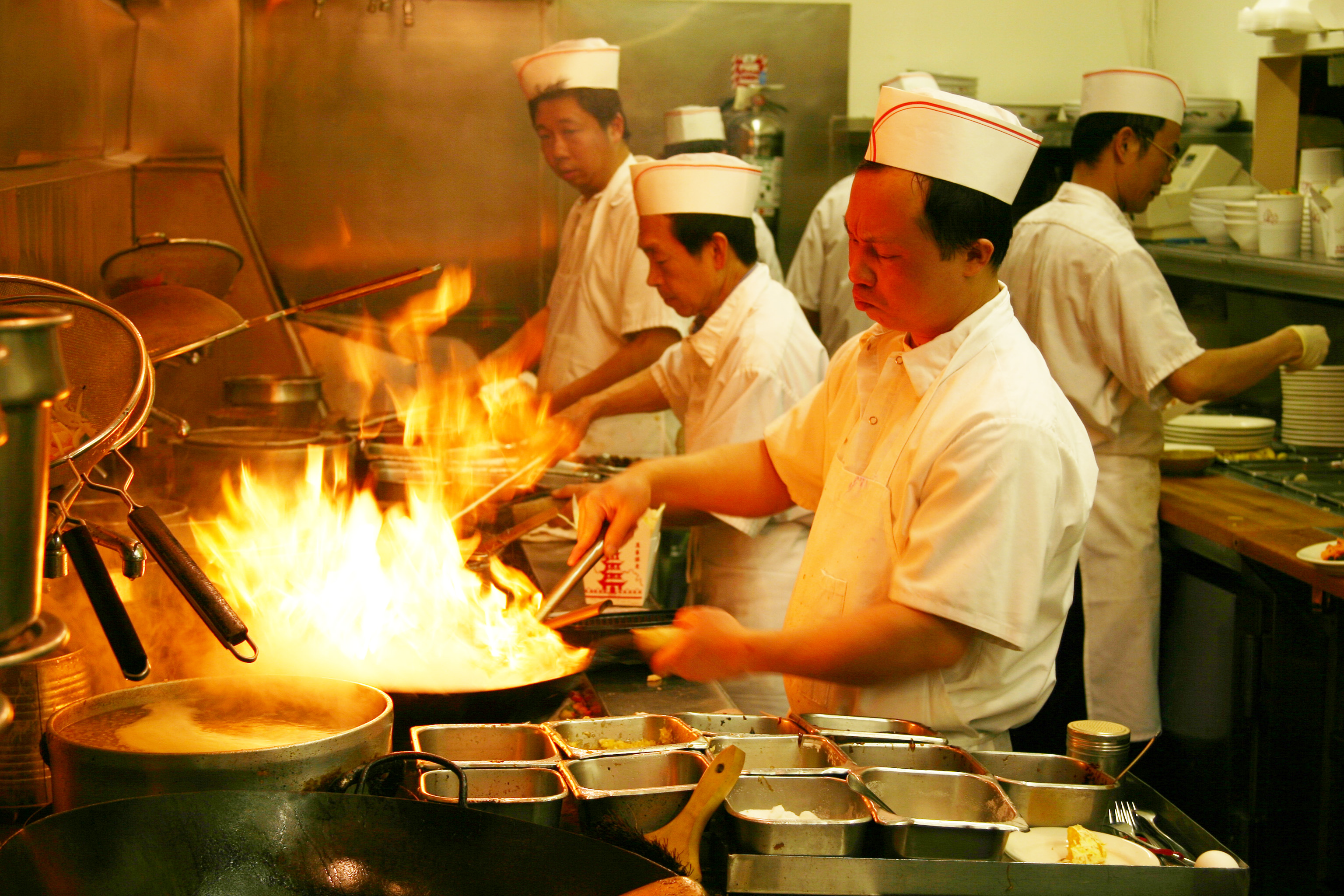|
Ginger Milk Curd
Ginger milk curd, also known as ginger-juice milk curd, ginger milk pudding or simply ginger milk, is a Chinese hot dessert originated in Shawan Ancient Town, Panyu District, Guangzhou in the Guangdong Province in southern China. The main ingredients are ginger, milk, and sugar. Water buffalo milk is used in the original recipe. Method of preparation First, cut a piece of old ginger into small pieces and finely grind the ginger. Then, squeeze the juice out by pressing the ginger through a sieve. Put the juice into a bowl. Next, bring the milk to a boil and dissolve sugar in milk. Take off heat and allow it to cool a little. If one is available, place a kitchen thermometer into the milk. The optimum curdling temperature is . In the meantime, stir the ginger juice thoroughly. When the milk temperature decreases to around 70-75 °C, pour the milk quickly into the middle of the ginger juice. Wait for two to three minutes. The milk will then be curdled, and may be eaten w ... [...More Info...] [...Related Items...] OR: [Wikipedia] [Google] [Baidu] |
China
China, officially the People's Republic of China (PRC), is a country in East Asia. It is the world's List of countries and dependencies by population, most populous country, with a Population of China, population exceeding 1.4 billion, slightly ahead of India. China spans the equivalent of five time zones and Borders of China, borders fourteen countries by land, the List of countries and territories by land borders, most of any country in the world, tied with Russia. Covering an area of approximately , it is the world's third List of countries and dependencies by area, largest country by total land area. The country consists of 22 provinces of China, provinces, five autonomous regions of China, autonomous regions, four direct-administered municipalities of China, municipalities, and two special administrative regions of China, Special Administrative Regions (Hong Kong and Macau). The national capital is Beijing, and the List of cities in China by population, most populous cit ... [...More Info...] [...Related Items...] OR: [Wikipedia] [Google] [Baidu] |
Thermometer
A thermometer is a device that measures temperature or a temperature gradient (the degree of hotness or coldness of an object). A thermometer has two important elements: (1) a temperature sensor (e.g. the bulb of a mercury-in-glass thermometer or the pyrometric sensor in an infrared thermometer) in which some change occurs with a change in temperature; and (2) some means of converting this change into a numerical value (e.g. the visible scale that is marked on a mercury-in-glass thermometer or the digital readout on an infrared model). Thermometers are widely used in technology and industry to monitor processes, in meteorology, in medicine, and in scientific research. History While an individual thermometer is able to measure degrees of hotness, the readings on two thermometers cannot be compared unless they conform to an agreed scale. Today there is an absolute thermodynamic temperature scale. Internationally agreed temperature scales are designed to approximate this clo ... [...More Info...] [...Related Items...] OR: [Wikipedia] [Google] [Baidu] |
Puddings
Pudding is a type of food. It can be either a dessert or a savoury (salty or spicy) dish served as part of the main meal. In the United States, ''pudding'' means a sweet, milk-based dessert similar in consistency to egg-based custards, instant custards or a mousse, often commercially set using cornstarch, gelatin or similar coagulating agent such as Jell-O. The modern American meaning of pudding as dessert has evolved from the original almost exclusive use of the term to describe savoury dishes, specifically those created using a process similar to that used for sausages, in which meat and other ingredients in mostly liquid form are encased and then steamed or boiled to set the contents. In the United Kingdom and some of the Commonwealth countries, the word ''pudding'' is used to describe sweet and savoury dishes. Savoury puddings include Yorkshire pudding, black pudding, suet pudding and steak and kidney pudding. Unless qualified, however, pudding usually means desse ... [...More Info...] [...Related Items...] OR: [Wikipedia] [Google] [Baidu] |
Macau Cuisine
Macanese cuisine ( zh, 澳門土生葡菜, pt, culinária macaense) is mainly influenced by Chinese cuisine, especially Cantonese cuisine and European cuisine, especially Portuguese cuisine and influences from Southeast Asia and the Lusophone world, due to Macau's past as a Portuguese colony and long history of being an international tourist gambling centre. ''Minchi'', egg tarts, pork chop buns, ginger milk and almond cakes are some of the region's most common delicacies. Common cooking methods make use of various spices such as turmeric, coconut milk, and cinnamon to give dishes an extra kick of aroma and enhancement of taste. Many routinely consumed dishes in Macau belong to a subclass (Heungshan) of Cantonese cuisine. Many Macanese dishes resulted from the spice blends that the wives of Portuguese sailors used in an attempt to replicate European dishes with local Chinese ingredients and seasonings. Typically, Macanese food is seasoned with various spices including turmeric, ... [...More Info...] [...Related Items...] OR: [Wikipedia] [Google] [Baidu] |
Curd
Curd is obtained by coagulating milk in a sequential process called curdling. It can be a final dairy product or the first stage in cheesemaking. The coagulation can be caused by adding rennet or any edible acidic substance such as lemon juice or vinegar, and then allowing it to coagulate. The increased acidity causes the milk proteins ( casein) to tangle into solid masses, or ''curds''. Milk that has been left to sour ( raw milk alone or pasteurized milk with added lactic acid bacteria) will also naturally produce curds, and sour milk cheeses are produced this way. Producing cheese curds is one of the first steps in cheesemaking; the curds are pressed and drained to varying amounts for different styles of cheese and different secondary agents (molds for blue cheeses, etc.) are introduced before the desired aging finishes the cheese. The remaining liquid, which contains only whey proteins, is the whey. In cow's milk, 90 percent of the proteins are caseins. Curds ca ... [...More Info...] [...Related Items...] OR: [Wikipedia] [Google] [Baidu] |
Cantonese Cuisine
Cantonese or Guangdong cuisine, also known as Yue cuisine ( or ) is the cuisine of Guangdong province of China, particularly the provincial capital Guangzhou, and the surrounding regions in the Pearl River Delta including Hong Kong and Macau.Hsiung, Deh-Ta. Simonds, Nina. Lowe, Jason. 005(2005). The food of China: a journey for food lovers. Bay Books. . p17. Strictly speaking, Cantonese cuisine is the cuisine of Guangzhou or of Cantonese speakers, but it often includes the cooking styles of all the speakers of Yue Chinese languages in Guangdong. Scholars categorize Guangdong cuisine into three major groups based on the region's dialect: Cantonese, Hakka and Chaozhou cuisines. The Teochew cuisine and Hakka cuisine of Guangdong are considered their own styles, as is neighboring Guangxi's cuisine despite eastern Guangxi being considered culturally Cantonese due to the presence of ethnic Zhuang influences in the rest of the province. Cantonese cuisine is one of the Eight ... [...More Info...] [...Related Items...] OR: [Wikipedia] [Google] [Baidu] |
Chinese Desserts
Chinese desserts () are sweet foods and dishes that are served with tea, along with meals"Chinese Desserts." . Accessed June 2011. |
List Of Desserts
A dessert is typically the sweet Course (food), course that, after the entrée and main course, concludes a meal in the culture of many countries, particularly western world, Western culture. The course usually consists of sweet foods, but may include other items. The word "dessert" originated from the French language, French word ''desservir'' "to clear the table" and the negative of the Latin language, Latin word ''servire''. There are a wide variety of desserts in western cultures, including cakes, cookies, biscuits, gelatins, pastry, pastries, ice creams, pies, puddings, and candy, candies. Fruit is also commonly found in dessert courses because of its natural sweetness. Many different cultures have their own variations of similar desserts around the world, such as in Russia, where many breakfast foods such as blini, oladyi, and syrniki can be served with honey and jam to make them popular as desserts. By type Brand name desserts A * Angel Delight B * Bird's Custard * Bomp ... [...More Info...] [...Related Items...] OR: [Wikipedia] [Google] [Baidu] |
List Of Chinese Desserts
Chinese desserts are sweet foods and dishes that are served with tea, along with meals"Chinese Desserts." . Accessed June 2011. [...More Info...] [...Related Items...] OR: [Wikipedia] [Google] [Baidu] |
Junket (dessert)
Junket is a milk-based dessert, made with sweetened milk and rennet, the digestive enzyme that curdles milk. Some older cookery books call the dish curds and whey. Preparation To make junket, milk (usually with sugar and vanilla added) is heated to approximately body temperature and the rennet, which has been dissolved in water, is mixed in to cause the milk to set. The dessert is chilled prior to serving. Junket is often served with a sprinkling of grated nutmeg on top. History Junket evolved from an older French dish, ''jonquet'', a dish of renneted cream in which the whey is drained from curdled cream, and the remaining curds sweetened with sugar. In medieval England, junket was a food of the nobility made with cream and flavoured with rosewater, spices and sugar. It started to fall from favour during the Tudor era, being replaced by syllabubs on fashionable banqueting tables and, by the 18th century, had become an everyday food sold in the streets. For most of t ... [...More Info...] [...Related Items...] OR: [Wikipedia] [Google] [Baidu] |
Douhua
Douhua () is a Chinese sweet or savoury snack made with very tender tofu. It is also referred to as doufuhua (), tofu pudding, soybean pudding or, particularly in northern China, tofu brains (). History Tofu is thought to have originated in ancient China during the Han Dynasty. Liu An, the grandson of Emperor Gaozu of Han, was ambitious and wanted to invent something to make people live forever. Even though he failed to make the magic pill, he used soybean and bittern to finally get niveous and tender tofu, which was surprisingly tasty. People named it "tofu brains" because of its softness. Tofu brains then became a popular snack during Han Dynasty. In the next 2000 years, it gradually spread throughout China. During the Second Sino-Japanese War, Sichuan became the political, economical, and military center of China. The boss of a famous Douhua restaurant, Liu Xilu, learnt the methods of making beancurd from others and innovated on them until he finally came up with hi ... [...More Info...] [...Related Items...] OR: [Wikipedia] [Google] [Baidu] |
Hydrophobic Effect
The hydrophobic effect is the observed tendency of nonpolar substances to aggregate in an aqueous solution and exclude water molecules. The word hydrophobic literally means "water-fearing", and it describes the segregation of water and nonpolar substances, which maximizes hydrogen bonding between molecules of water and minimizes the area of contact between water and nonpolar molecules. In terms of thermodynamics, the hydrophobic effect is the free energy change of water surrounding a solute. A positive free energy change of the surrounding solvent indicates hydrophobicity, whereas a negative free energy change implies hydrophilicity. The hydrophobic effect is responsible for the separation of a mixture of oil and water into its two components. It is also responsible for effects related to biology, including: cell membrane and vesicle formation, protein folding, insertion of membrane proteins into the nonpolar lipid environment and protein-small molecule associations. Hence t ... [...More Info...] [...Related Items...] OR: [Wikipedia] [Google] [Baidu] |


.jpg)





